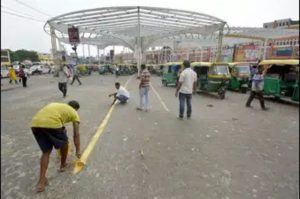Sealdah Station Traffic Laning — In a significant step toward decongesting one of the busiest urban junctions in India, authorities have introduced a detailed traffic laning system around Sealdah Railway Station. The move comes in anticipation of increased footfall and vehicular pressure once the long-awaited Sealdah–Esplanade East-West Metro stretch opens to the public.
Jointly executed by the Eastern Railway and the Kolkata Traffic Police, the new plan aims to redefine vehicular movement, streamline pedestrian flow, and ensure commuter safety in a zone that already handles over 20 lakh passengers daily.

The Problem: A Legacy of Chaos at Sealdah
Sealdah’s southern and main sections are hubs of intense activity—serving long-distance trains, suburban lines, buses, autos, taxis, app-cabs, and now a Metro station. Over the years, unregulated mixing of vehicles and people has made traffic snarls and crowding the norm.
With the Sealdah–Esplanade metro link expected to become operational by late 2025, the city anticipates a surge in intermodal transfers at Sealdah. Urban planners have therefore prioritized reorganizing the flow before the corridor goes live.


The Laning Strategy: Breaking Down the Plan
Authorities have introduced a tiered laning system with designated entry and exit routes, vehicle holding zones, and pedestrian segregation:
- Auto-rickshaws are now barred from entering beyond the station perimeter. Designated drop-off and pick-up points have been set up along Baithakkhana Road and B.R. Singh Hospital Road.
- App-based cabs and private cars are assigned specific lanes and waiting zones near the south gate of the station.
- A second prepaid taxi booth has been set up to disperse queues, while road medians and barriers have been added to guide vehicle entry.
- Pedestrian movement is being split: passengers from the main terminal are being guided to use Baithakkhana Road exits, while those from the south terminal are being directed toward B.R. Singh Hospital Road.
These changes are supported by signage, railings, lane markings, and an increased presence of traffic marshals.
Sealdah Station Traffic Laning: A Subway to Smooth the Flow
One of the most impactful developments is a subway opened from West Canal Road, connecting directly to the Sealdah South terminal. This avoids the notoriously congested APC Road stretch and allows smoother pedestrian ingress/egress from the Metro and Railway stations.
Authorities are reportedly studying a further extension of the subway to connect with Sealdah Court and B.R. Singh Hospital, aiming to offer a continuous, underground path for pedestrians and medical visitors.
Managing the Parcel Traffic
Parcel movement, long a source of congestion near Sealdah South, is also being reconsidered. Railway officials are in talks to:
- Relocate or downscale the existing parcel godown;
- Create a wider turning radius for loading vehicles;
- Streamline loading/unloading time slots to non-peak hours.
The Eastern Railway is reviewing architectural plans to accommodate these improvements in coordination with KMRC (Kolkata Metro Rail Corporation).
What the Commuters Say
The new system, while still being fine-tuned, has already received mixed but generally positive reactions.
Meena Ghosh, a daily commuter from Kankurgachi, said:
“Earlier it was a free-for-all. Now at least we know where to go for taxis or Metro. The new lanes make a difference during rush hours.”
Shahid Ali, an app cab driver, commented:
“Clear pickup zones help. But enforcement is key. If traffic cops aren’t there, autos and bikes start flouting the lanes.”
East-West Metro Expansion: Context and Urgency
The current Metro Green Line runs from Salt Lake Sector V to Sealdah. The final leg—Sealdah to Esplanade, including the iconic under-river tunnel, has undergone safety trials and is awaiting final approvals.
Once launched, the full East-West Corridor (16.6 km) will allow seamless travel between Salt Lake and Howrah via the city center—transforming Sealdah into a major interchange hub.
Related link:
KMRC East-West Metro Corridor Details (Kolkata Metro Rail Corporation)
What’s Still Pending
Though the laning system is in place, several upgrades are still underway or under review:
- Digital signage systems for vehicle guidance;
- Smart surveillance cameras to monitor encroachments and illegal stops;
- Improved lighting and sidewalk coverage for late-night commuters;
- Unified ticketing zones between Metro and Rail platforms (planned for future integration).
Expert Voices: Will It Work?
Urban planner Dr. Debanjan Sen from Jadavpur University noted:
“This is a necessary transition. Intermodal points like Sealdah must become smarter. What matters now is sustainability—consistent enforcement, smart feedback mechanisms, and commuter education.”
Looking Ahead
With the final Metro stretch expected to launch by late 2025, Kolkata’s transport ecosystem is on the brink of a major shift. Sealdah, as its beating heart, must adapt rapidly—and early signs suggest it is.
The real test, however, will come once full operations begin and the laning plan faces real-world pressure from lakhs of daily commuters.
Also read: Home | Channel 6 Network – Latest News, Breaking Updates: Politics, Business, Tech & More

